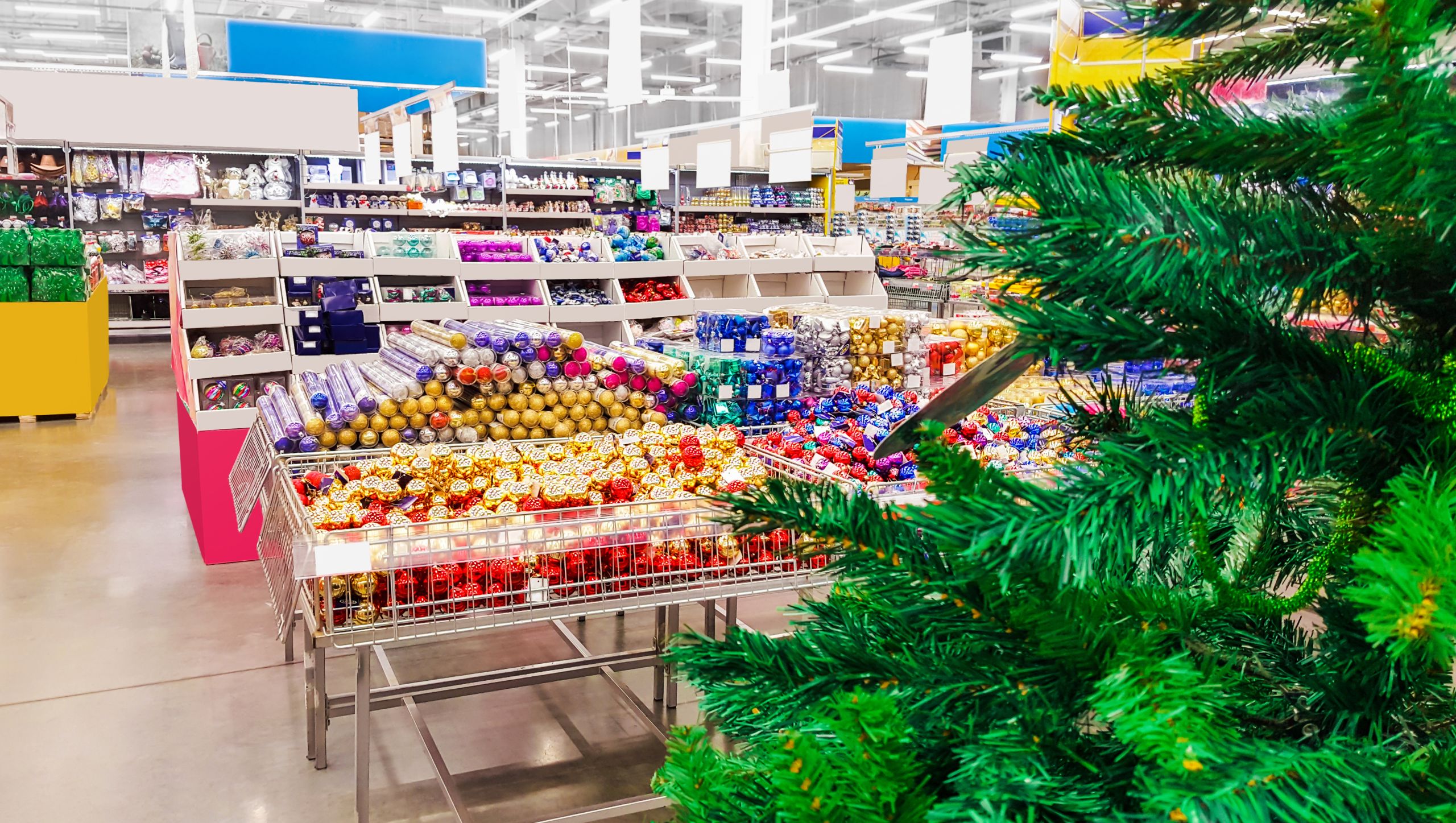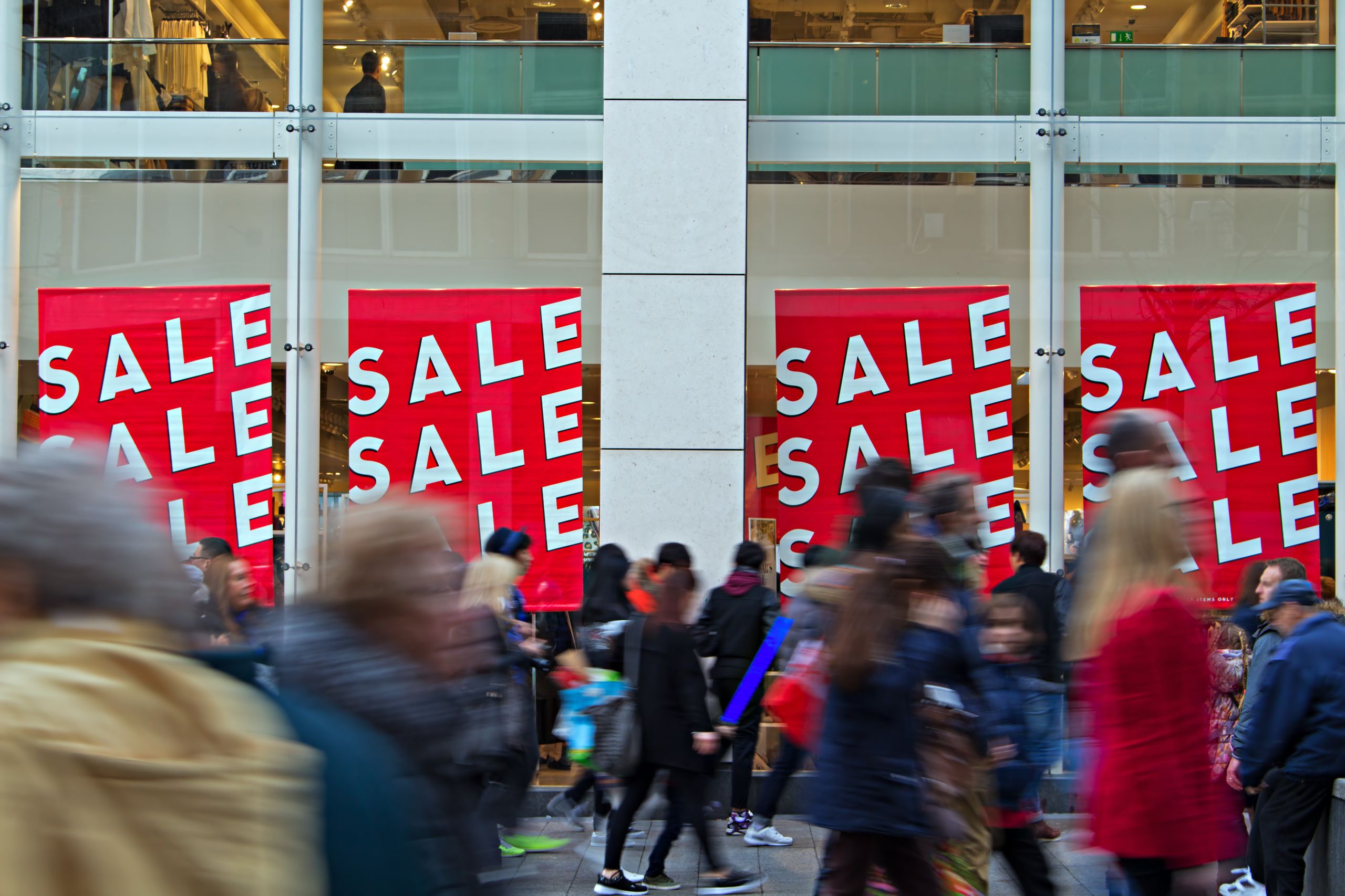Spotlight on Christmas trading
What retailers can learn from golden-quarter trends


UK retail sales in December were notable for one thing: they resulted in the worst trading performance since 2008 as consumers tightened their belts across all sectors, including festive food.
Trading on ‘Super Saturday’ gave some retailers a last-minute uplift, but it was a weak end to a punishing quarter.
Debenhams, B&M and Marks & Spencer all cited tough trading conditions early on in the golden quarter as a reason for their poor sales performance.
A combination of November’s mild weather, consumer uncertainty over Brexit and Black Friday discounting battered sales volumes and profit margins.
But the fallout from Christmas 2018 could have been a lot worse. Retailers can learn lessons from those that prospered.
Profit warnings
December began with profit warnings from Superdry, Bonmarché and – most alarmingly – Asos, a darling of the City, while HMV went into administration within days of Christmas. All this led many to fear more bad news as retailers updated on their festive trading in January.
However, there was some good news as Next and Tesco outperformed expectations, while sales at Ted Baker – ranked fourth on Retail Week’s Christmas trading table – grew 12.2% on the same period last year.
A raft of retailers experienced online sales growth at the expense of in-store footfall, with Fat Face, Next, Joules, Debenhams and Fortnum & Mason reporting an acceleration of this trend over Christmas. Meanwhile, Selfridges and Hobbycraft showed that in-store events offered customers a good reason to go into shops to spend in the three-week period leading up to Christmas.
“It wasn’t all doom and gloom,” says Lisa Hooker, UK leader of industry for consumer markets at PwC. “Some fashion brands continued their stellar growth, and there were general merchandise winners as diverse as Hobbycraft and Dunelm.”
This guide, produced in association with PwC, includes a full trading table, digs deeper into the trends that shaped Christmas and offers vital insight for retailer planning in 2019.
CHRISTMAS TRADING TABLE
Sales growth or decline – how did retailers fare?

| Retailer | Period | Like-for-likes sales 2018 (%) | Like-for-likes sales 2017 (%) |
|---|---|---|---|
| Gear4music | Four months to December 31 | 41* | 42* |
| Seasalt | Five weeks to January 5 | 35 | N/A |
| The Entertainer | Five weeks to December 29 | 22.4* | N/A |
| Ted Baker | Five weeks to January 5 | 12.2* | 9* |
| Mountain Warehouse | 13 weeks to January 6 | 12* | 33.1 |
| Joules | Seven weeks to January 7 | 11.7* | 19.2* |
| Aldi | Seven days to December 23 | 10* | 15* |
| Hobbycraft | Six weeks to December 24 | 9.5 | N/A |
| Dunelm | 13 weeks to December 29 | 9 | 3.4 |
| Quiz | Six weeks to January 5 | 8.4* | 32* |
| AO.com | Three months to December 31 | 8.2 | 11.2 |
| Boux Avenue | Six weeks to December 24 | 8.1 | -2.8 |
| Lidl | Six weeks to December 30 | 8* | 16* |
| Dobbies | Six weeks to December 30 | 8 | N/A |
| Selfridges | December 1 to 24 | 8* | 10* |
| Majestic Wine | 10 weeks to December 31 | 6.3 | 1.3 |
| Pets at Home | 12 weeks to January 3 | 5.1 | 7.2 |
| Matalan | Five weeks to December 29 | 4* | N/A |
| Primark | 16 weeks to January 5 | 4 | 7* |
| Ryman | Six weeks to December 24 | 3.9 | 4.8 |
| Shop Direct | Seven weeks to December 28 | 3.7 | 6.3* |
| Morrisons | Nine weeks to January 6 | 3.6 | 2.8 |
| Booths | Three weeks to January 5 | 3.3* | N/A |
| Tesco | Six weeks to January 5 | 2.6 | 2.3 |
| Morleys | Six weeks to January 5 | 2.3 | N/A |
| Game | Seven weeks to January 5 | 2^ | 5.2^ |
| Next | Nine weeks to December 29 | 1.5** | 1.5** |
| Robert Dyas | Six weeks to December 24 | 1.1 | 2 |
| John Lewis | Seven weeks to January 5 | 1 | 3.1 |
| Dixons Carphone | 10 weeks to January 5 | 1 | N/A |
| Waitrose | Seven weeks to 5 January | 0.3 | 1.5 |
| Moss Bros | 23 weeks to January 5 | -1 | -8 |
| Sainsbury’s | 15 weeks to January 5 | -1.1 | 1.1 |
| Topps Tiles | 13 weeks to December 29 | -1.4 | 3.4 |
| B&M | September 30 to December 29 | -1.6 | 3.9 |
| N Brown | 18 weeks to January 5 | -1.6* | 3.2* |
| M&S | 13 weeks to December 29 | -2.2 | -1.4 |
| Halfords | 14 weeks to January 4 | -2.2 | 2.7 |
| Debenhams | Six weeks to January 5 | -3.4 | -1.3 |
| New Look | Month of December | -5.7 | N/A |
| Fat Face | Five weeks to January 5 | -6^^ | 8 |
| Mothercare | 13 weeks to January 5 | -11.4^ | -7.2 |
NB: Not all reporting periods are directly comparable.
*Total sales, **Full-price sales, ^UK like-for-likes, ^^Total UK store sales
SECTOR BY SECTOR
While there were hints of growth in womenswear, general merchandise felt the effects of cautious customer spending.

- Sales of toys dropped by double digits, impacting Argos and Sainsbury’s
- Aldi topped the grocery sector with sales growth of 10.4%
- John Lewis drove return on investment in own-brand womenswear
With November’s trading conditions described by Mike Ashley as the “worst in living memory”, the stage was set for a tough game of catch-up in December.
Data from the British Retail Consortium confirmed that sales in non-food sectors dropped 1.2% over the three months to December, with a further decline in the last month of the year.
But there was some good news in womenswear. Amid a crowded and competitive market, John Lewis’ investment in its own-brand ranges was rewarded with a 14.7% increase in sales.
And Tesco bucked the weak performance of the apparel market in December to claim a 3.8% year-on-year rise in sales of its own-brand, F&F.
"Fashion saw a late surge, which benefited retailers who truly understood why shoppers value their brand and were able to deliver online and in-store seamlessly"
Fashion retailer Joules generated double-digit growth in the seven weeks to January 7, with half of sales coming from online.
Joules chief executive Colin Porter said the strong growth was down to the “flexibility of our ‘total retail’ model, which enables Joules to adapt to changing customer shopping behaviours”.
“After a slow start to the season and some profit warnings in November, fashion saw a late surge similar to other sectors,” says Lisa Hooker of PwC.
“This benefited retailers who truly understood why shoppers value their brand, delivered products true to that and were able to deliver online and in-store seamlessly.”
General merchandise woes
The issuing of a profit warning by Halfords on the release of its Christmas trading update is an indication of the challenges facing general merchandise sales.
Pointing to the tough trading conditions in November, as well as “weak consumer confidence”, chief executive Graham Stapleton described the third quarter as “challenging”.
Argos’ decision to do less promotional activity around Black Friday resulted in a decline in golden-quarter sales.
Sainsbury’s chief executive Mike Coupe believes the “extremely cautious” way in which consumers have spent their money has impacted the general merchandise market, “where purchases to some extent are discretionary”.
“When the full reporting season is over, you will get a flavour of how challenging it has been in many of the general merchandising and clothing markets,” said Coupe.
Consumers shopping at Sainbury’s and Argos clearly viewed toys as “discretionary” with sales in this category declining, symptomatic of a double-digit drop in sales across the UK toys market.
Meanwhile, B&M, usually a reliably strong performer over Christmas, suffered a like-for-like sales decline of 1.6%, compared with the previous year’s growth of 3.9%.
Interestingly, B&M claimed a victory for not participating in Black Friday with a “pleasing quarter in terms of gross margin”, according to chief executive Simon Arora.
"When the full reporting season is over, you will get a flavour of how challenging it has been in many of the general merchandising and clothing markets"
Festive food
While many sectors suffered stagnancy and decline, the grocery market achieved growth of 0.6% on a like-for-like basis, equivalent to golden-quarter sales of £29.3bn, according to Kantar Worldpanel data.
On grocery sales alone, Asda achieved the highest growth of the big four, according to Kantar data. However, Aldi stole the show for overall growth in year-on-year grocery sales in the 12 weeks to December 30, 2018 – although this was driven by an aggressive store opening programme.
Meanwhile, Tesco and Morrisons both grew like-for-like sales on 2017 golden-quarter trading.
Tesco attributed its 2.6% rise to “outperformance in all key categories including food, clothing and general merchandise”.
Morrisons meanwhile tipped the wink at its wholesale business, selling to retailers such as Amazon, for its 3.6% growth.
Asda had not released its full Christmas trading figures at the time of going to press.
Share of festive food spend
| Grocer | Market share for Christmas 2018 | Sales growth |
|---|---|---|
| Tesco | 27.8% | 0.6% |
| Sainsbury’s | 16.2% | -0.4% |
| Asda | 15.2% | 0.7% |
| Morrisons | 10.6% | 0.1% |
| Aldi | 7.4% | 10.4% |
| Co-op | 5.9% | 3.2% |
| Lidl | 5.4% | 9.4% |
| Waitrose | 5% | -1.7% |
| Iceland | 2.3% | 0.1% |
Source: Kantar Worldpanel
Festive food facts
94% – the increase in sales of Waitrose’s meat-free range over Christmas
£100m – the contribution from Sainsbury’s Free From category to annual sales
£383 – the average grocery bill in December
-7% – the decline in year-on-year turkey sales
SEEKING VALUE
Consumers were conservative with their festive spend this year, leading grocers to miss out on an expected boost from premium lines.

- Shoppers fail to “splash out” this Christmas
- Sainsbury’s reports shoppers “downtraded” on festive food
- Discounts were deep, but less overall than in 2017
A trend retailers can usually bet on over the festive period, particularly in the grocery sector, is consumers treating themselves by ‘trading up’ to more premium brands.
Not so this year – at least for some retailers, who noted that consumers’ recent value-conscious behaviour also extended, unusually perhaps, to Christmas spending.
British Retail Consortium chief executive Helen Dickinson pointed to “squeezed consumers choosing not to splash out this Christmas”.
Two of the UK’s largest retailers also noted the trend. Morrisons chief executive David Potts reported slow growth within its Best premium range, compared with the past two to three years, as shoppers became “increasingly savvy and cautious”.
And Sainsbury’s Mike Coupe saw evidence of customers “downtrading”, resulting in a lower-than-expected average item spend – one reason for the grocer’s decline in sales.
It was not a trend experienced by all the grocers, though, with German discount retailers Aldi and Lidl both celebrating rises in their premium food product ranges.
Lidl even claimed its 33% spike in Deluxe premium lines had swiped £58m off the sales figures of Waitrose, Marks & Spencer and the big four.
Meanwhile, Tesco chief executive Dave Lewis said spending on the grocer’s Finest range was unchanged and reported “no difference in this year’s Christmas trading to last year’s”.
Deep discounting
As consumers tightened their belts, retailers used discounting to win market share.
While an extended Black Friday promotion worked well for some – such as the John Lewis Partnership – others that did not take part bemoaned its effect on growth.
"Extended deeper discounting led even Asos to issue a profit warning in November, due to the damaging impact price cuts were having on margins"
Marks & Spencer cited Black Friday and “widespread discounting by our competitors” for a 2.2% decline in like-for-like Christmas sales growth.
Extended deeper discounting led even Asos to issue a profit warning in November, due to the damaging impact price cuts were having on margins.
But, despite the promotional environment, PwC data reveals that fewer retailers were on Sale compared with Christmas 2017, with 53% running promotions in the third week of December 2018, compared with 70% in the same week the previous year.
However, Lisa Hooker from PwC does not blame Black Friday for this trend. “While Black Friday has remained popular with shoppers, our research found they increasingly used these promotions to buy things for themselves, for example fashion and electricals, and much less so for buying gifts,” she says. “So we don’t think it cannibalised the key mid-December sales period.”
Source: PwC Promotions Data
IN STORE VS ONLINE
Online sales were up while fewer shoppers visited stores, providing challenges for retailers balancing operational costs.

- Online sales volumes increased for most
- Retailers consider impact of ecommerce on profit margins
- In-store events paid off for Selfridges and Hobbycraft
As with Christmas trading in 2017, online sales were much brisker than on the high street, despite milder weather this year.
Although December’s online penetration rate only increased by 1.1% year on year to 31.2%, according to British Retail Consortium data, many retailers reported significant jumps in digital channel usage.
John Lewis fulfilled 52% more click-and-collect orders this year than last.
Ted Baker also experienced strong online sales growth, with web revenue up 18.7% over Christmas.
Boux Avenue, part of Theo Paphitis Retail Group, reported that online sales accounted for 43% of its festive revenue, while footfall to key locations was “sluggish”.
"Springboard found the total number of consumers on the high street, in retail parks and in shopping centres dropped 2.5% – on top of a 3.5% fall the previous year"
Fat Face attracted fewer shoppers in store during the golden quarter, resulting in a year-on-year 6% sales drop across its UK bricks-and-mortar business.
The retailer, however, pointed to a “shift to online sales in the UK” as the cause of the decline, with ecommerce sales up 16% in the same period.
Springboard data backs up retailers’ comments regarding declining footfall. The consultancy found that the total number of consumers on the high street, in retail parks and in shopping centres dropped 2.5% this Christmas – on top of a 3.5% fall the previous year.
Balancing online and offline
Clearly, online represents a huge opportunity for many retailers that are experiencing their store sales wither away. However, with online sales growth comes a cost conundrum, highlighted this year by Next.
Next suffered a 9% slump in physical sales of full-price products, countered by a 15% boost in online sales.
But in the world of retail’s new economics, an increase in online volume does not simply compensate for a drop in in-store sales.
A rise in online sales conversely resulted in the retailer forecasting a fall in profits, which Next in part blamed on the extra burden of increased operational costs attached to web sales. It reduced its full-year profit guidance by £4m and attributed £2.5m of that to the rising cost of fulfilling online orders.
19p
The amount of profit Next takes from every £1 spent on its ecommerce site
The bellwether stated in a review of its 2017 financial performance that the online business has significant variable costs, such as delivery and returns processing, which increase with greater sales volumes.
Mothercare is another retailer still seeking to find a cost balance between physical and digital retail.
The retailer is bottom of the Retail Week trading league table, with like-for-like sales bombing by 11.4% as online sales tumbled 16.3%.
Mothercare, ironically, said its online sales suffered on the back of its store closure programme, because fewer customers were able to order online from in store iPads.
“Ecommerce alone is no longer a guarantee of double-digit sales growth,” says Lisa Hooker of PwC. “One in three online shoppers told us they experienced problems this year, predominantly around range, price and functionality, rather than the delivery problems of the past.”
In-store experience
The rise of online orders in 2018 suggests that shoppers are seeking a more convenient, transactional way of buying Christmas gifts, food and drink.
Two retailers, however, showed that in-store experience can lead to effective results in driving bricks-and-mortar sales.
Hobbycraft hosted 12 weeks of festive workshops and demonstrations across 94 of its stores in the run-up to Christmas, which were attended by 21,000 shoppers.
The result was a 9.5% increase in like-for-like sales in the six weeks to December 24, bolstered by a 7.1% uptick in like-for-like sales in store.
2x
Hobbycraft sold double the number of Christmas Eve boxes after an in-store demo
Meanwhile, Selfridges reported that revenues climbed 10% in its Oxford Street store in the 24 days leading up to Christmas.
The premium department store hosted a variety of events, from a Christmas cabaret to daily confetti cannons and pop-up choirs.
The store has also extended its accessories hall into what it claims is the largest in the world.
Managing director Anne Pitcher said that newness, exclusive product and in-store entertainment were all key to its record performance.
"One in three online shoppers told us they experienced problems this year, predominantly around range, price and functionality, rather than the delivery problems of the past"
PARTNER COMMENT
It may be a challenging time for retail, but the winners this Christmas all realised some common truths, says Lisa Hooker of PwC UK.


Lisa Hooker, PwC UK
Lisa Hooker, PwC UK
The headlines talked about the worst Christmas for UK retail in a decade, capping off a year in which an estimated 150,000 jobs were lost across the sector.
But, amid the turmoil, there have been successes. So what were the secrets of Christmas’ winners? We saw four common themes…
1. Understand why customers shop with you and be true to your brand
It’s no surprise that some of the biggest fashion successes came from brands that maintained their authenticity, whether through the consistent product handwriting of some more premium brands or simply by offering the best-value fast fashion.
Know what makes your customers love you – and give them more of what they want.
2. Be where your customer wants you to be
And that means well-located stores, as well as online.
Consumers told us half of all their Christmas shopping was still done in stores, and in categories where experience or proximity are key (such as hobbies and pocket-money toys). Retailers that understood this prospered.
Even multichannel retailers credited their stores for some of their online success, with a quarter of all online shoppers click-and-collecting.
3. Keep your customers with you – even when wallets are squeezed
It’s no surprise that the most successful supermarkets this Christmas invested in value ranges while also innovating in premium own-brand to allow customers to treat themselves.
And there was also outperformance from some retailers that offered credit to ease the burden on stretched shoppers.
4. Your people are what makes the difference
There may be a temptation to cut staff costs if sales are under pressure, but knowledgeable and motivated colleagues were a common thread among retail’s winners. It may be a cliché, but great customer service – whether in store or online – can be the difference between clinching or losing a sale.
As we head into 2019, there will be more challenges ahead.
Consumers are tightening their belts, cost headwinds are not abating and the relentless channel shift online will put more pressure on the high street – and that’s without even mentioning Brexit.
However, we believe there will be an opportunity for forward-thinking retailers to steal a march on their competitors by investing in their people, their proposition and their operating model, and by embracing technology, partnerships and social ecommerce to enhance their offering.
Lisa Hooker is UK leader of industry for consumer markets at PwC. She leads the retail and consumer division, with a specialism in mergers and acquisitions. Hooker’s passion for understanding the challenges of diverse business models has enabled her to work across a broad variety of the UK’s biggest brands in multiple geographies.
For more insight, visit pwc.co.uk/industries/retail-consumer.html
Download Brave new world: leading through digital transformation, a research report from Retail Week and PwC that shines a light on the tactics, techniques and technologies retail’s c-suite are using to navigate their way through the industry’s digital transformation.
Spotlight on Christmas trading
What retailers can learn from golden-quarter trends
Written by Rose Bundock
Produced by Emily Kearns and Rebecca Dyer
In partnership with PwC
RW Guides brought to you by Retail Week
